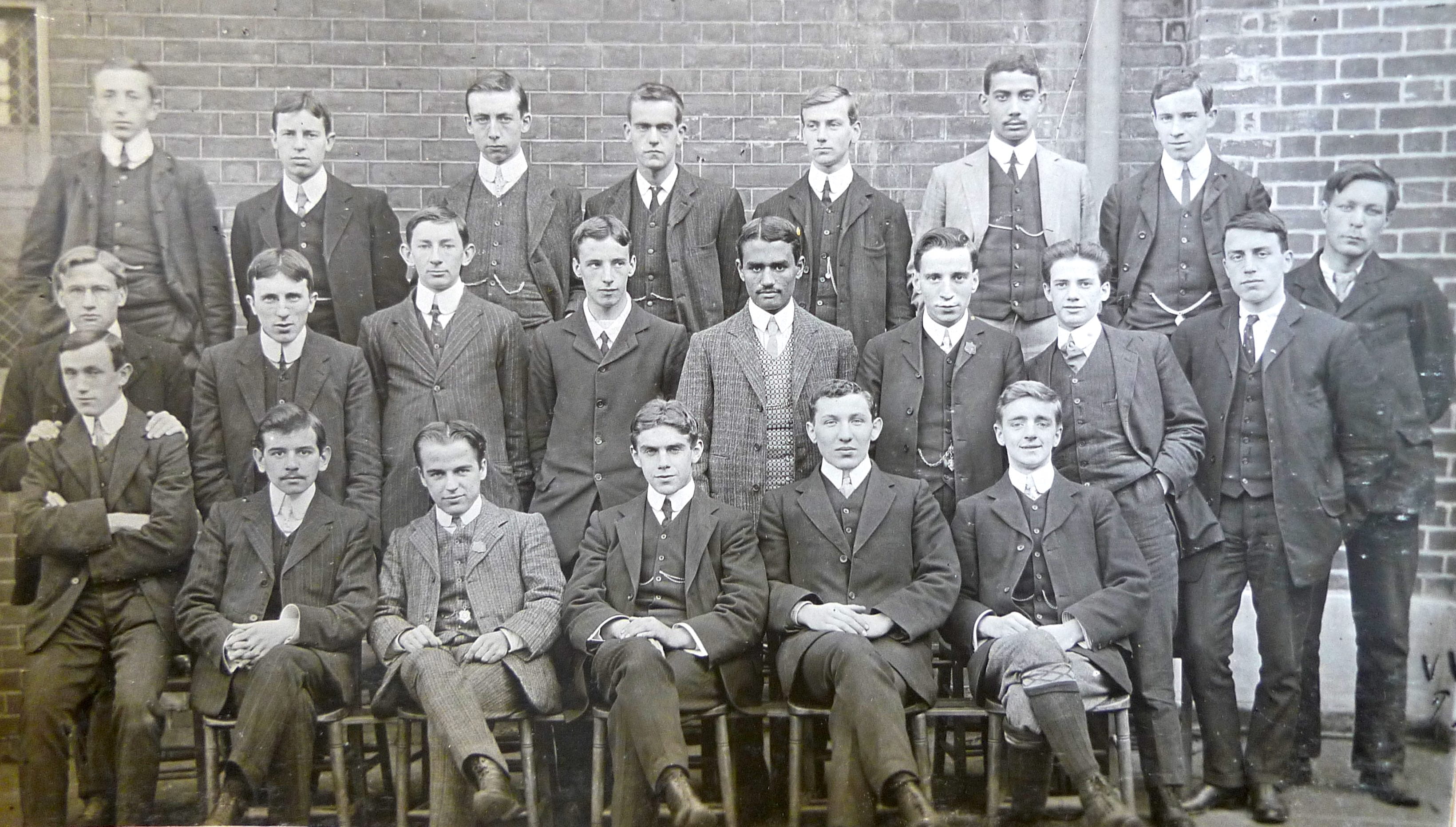
Two Egyptian students studying to be teachers at Goldsmiths between 1907-9. Image: Goldsmith, University of London archives. Back row second from the right and middle row standing at centre.
They were apparently the first overseas students to study at University of London, Goldsmiths’ College, as it was then calling itself.
They were two young Egyptian men who enrolled on the two year training certificate for qualification as a teacher between 1907 and 1909.
The spelling of their names varies in documentation: Osman Fareed (or Farid) and Mohommet (or Mohammed) Subhi.
Mr Fareed appears to be standing in the middle of the second row.
Mr Subhi second from the right standing at the back.
They had all the appearance of young Edwardian gentlemen like their fellow students.
Mr Subhi sports the traditional pocket-watch with its chain visible on the outside of his waistcoat.
Mr Fareed’s waistcoat is more colourfully patterned, despite the black and white nature of the image.
His moustache has gone by the time he features in the College first Rugby XV a year later in 1908.
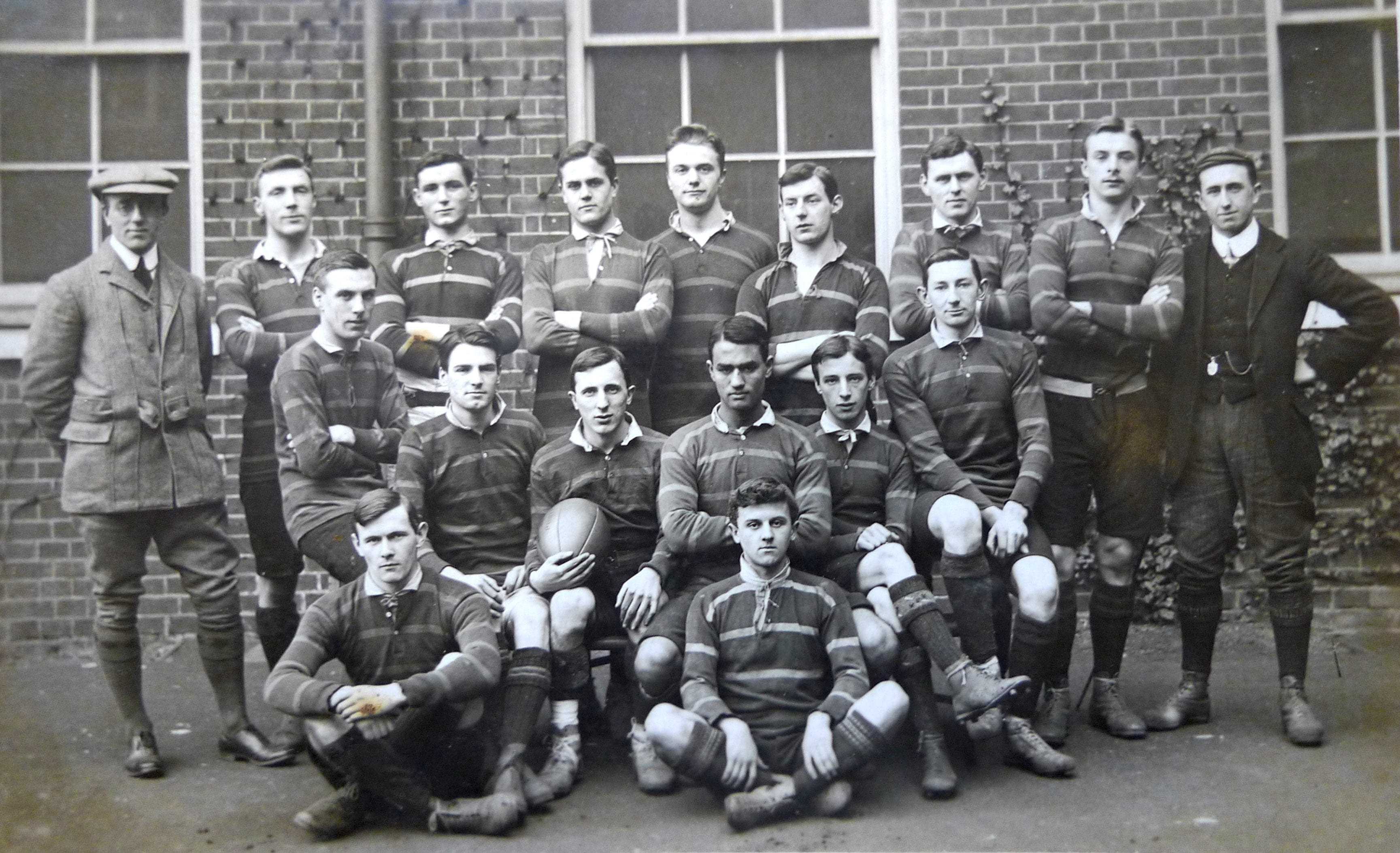
Osman Fareed from Egypt, arms crossed, sitting in the second row third from the right by the side of the team captain who is holding ball. Image: Goldsmiths, University London archive.
The Egyptian students were among the few trainee teachers paying private fees.
Most of students in ‘The Training Department’ from Britain were sponsored by bursaries provided by county education authorities anxious to promote and fund the recruitment of qualified teachers in their expanding local authority schools at Elementary and Secondary level.
At present what we know about Osman and Mohammed can be gleaned from the meticulous records in Goldsmiths’ student archives and two very grandly embossed volumes ‘University of London, Goldsmiths’ College, Training Department: Record cards of those students who left the training college in July 1909′.
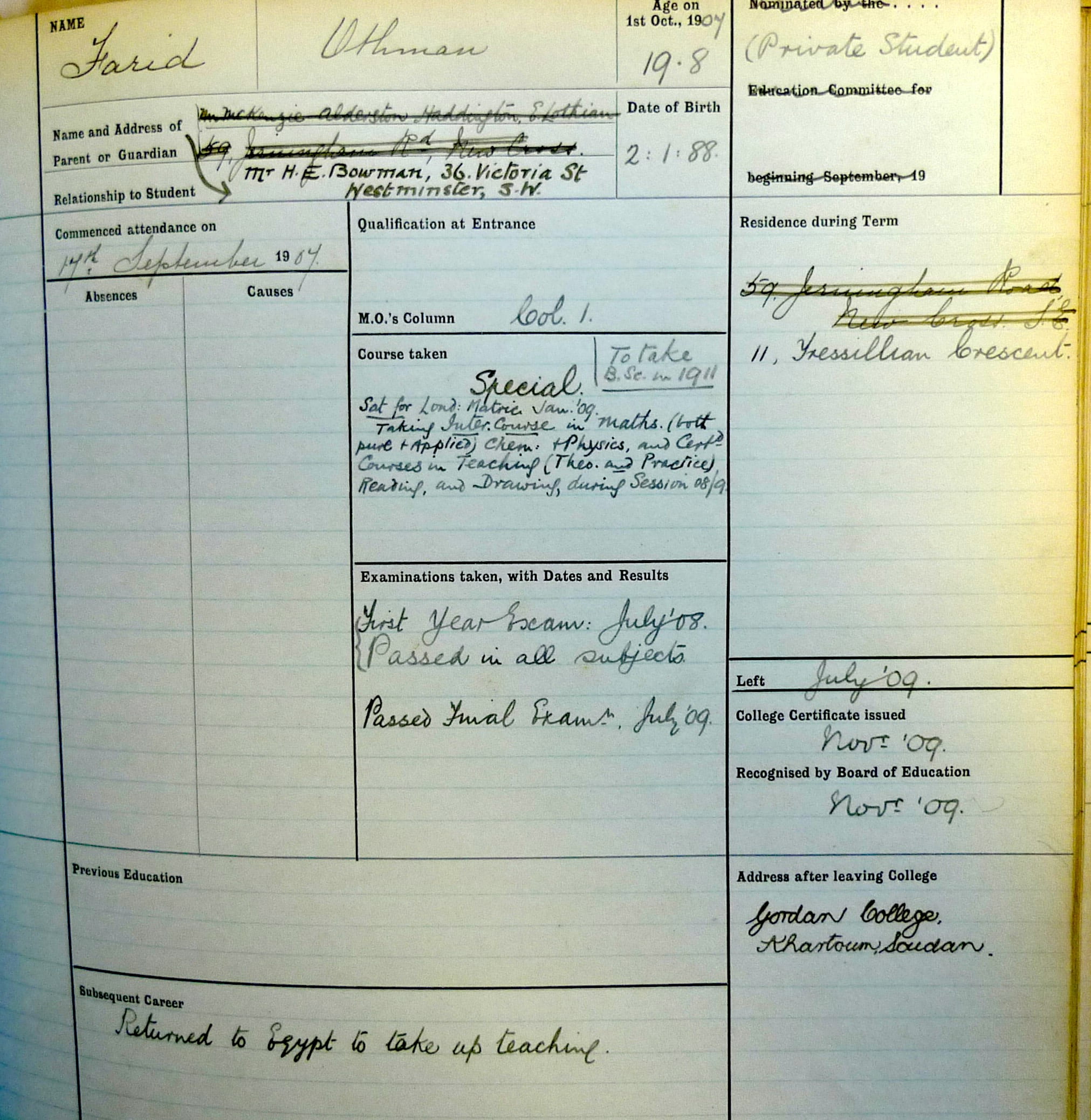
Osman Farid’s student record card from the Goldsmiths Archives. Image: Goldsmiths, University of London Archive.
It can be seen that Osman was 19 years old when he started his teacher training course in 1907.
The name of his guardian is a Mr H.E Bowman of 36 Victoria Street, Westminster, the same man acting as guardian to his fellow Egyptian Mohammed Subhi.
The record shows that he ‘returned to Egypt to take up teaching’ and resided and worked at Gordon College in Khartoum, Sudan after qualifying.
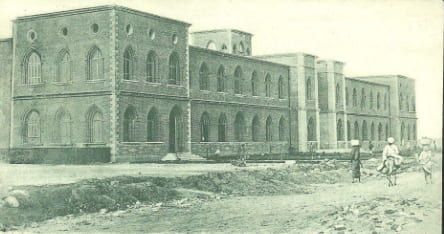
Gordon College, Khartoum which would later evolve into the University of Khartoum.
Gordon College would later become the founding institution of the prestigious University of Khartoum.
It’s also clear that he has taken special courses in matriculating for a University of London BSc degree that he intended to complete in 1911. While completing his teacher training at Goldsmiths he took extra courses in Pure and Applied Maths, Chemistry and Physics.
We also know that Mr Farid/Fareed became a life-time member of the Goldsmiths College Old Students Association (GCOSA).
By the time of the beginning of the 20th century’s second World War in 1939, he was working for the Ministry of Education in Cairo.
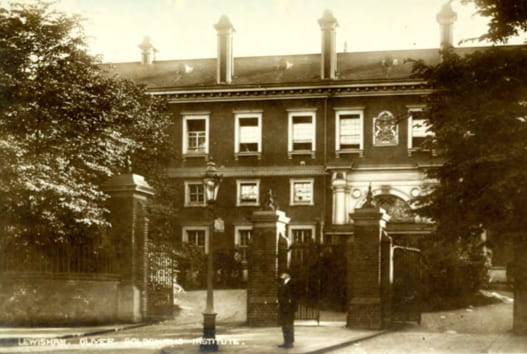
Entrance to Goldsmiths’ College early 20th Century as the Egyptian students would have seen it. Image: Goldsmiths, University of London archive.
As a rugby player he was in a team that was experiencing more defeats than victories.
Rugby Union had not been played as sport by Egyptians.
If it was played at all it would have been the preserve of the British Army which had the country under virtual military occupation.
It was reported that on the 23rd January 1909 on the College ground (the playing field behind the main building) they were beaten by Holborn Circus 15 points to ‘Smiths 6 points: ‘Holborn seemed to be in the better humour for the boxing ring than the football field.’
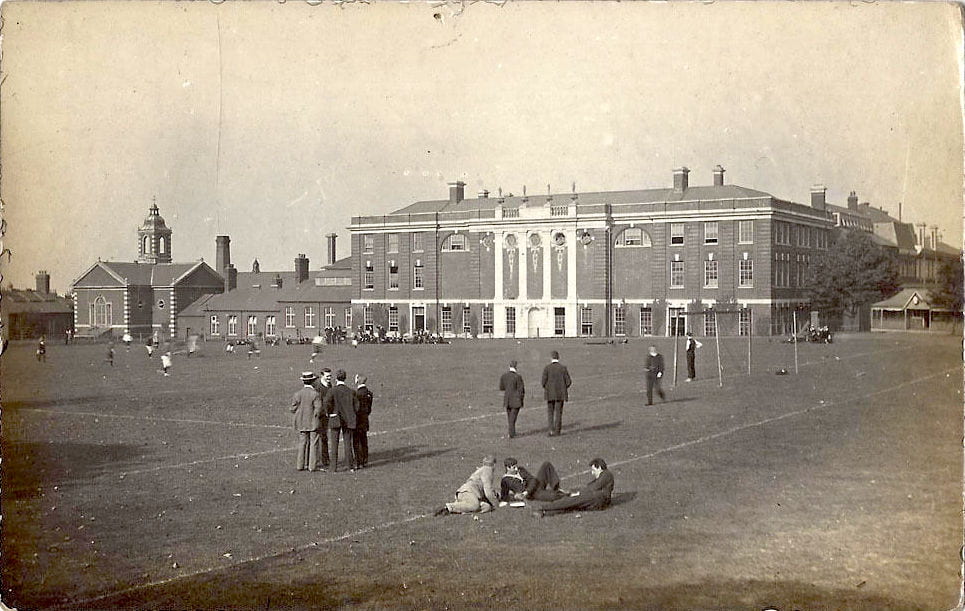
Goldsmiths’ playing field in 1908 where the home rugby matches would have been played. The Blomfield new Art School block was completed in that year and shown in this image. During the first 2 years of the college this was an open quadrangle. Image: Goldsmiths, University of London archive.
More defeats that year included a thrashing one week later on 30th January by the rival side Boro Road College 29-nil.
That match was played at the college in front of a big and enthusiastic local crowd as Goldsmiths’ and Boro Road (from a college in Borough which would be one of the founding parts of South Bank University) were the leading teacher training colleges in London.
It was in the manner of a local derby as both colleges were located south of the River Thames.
The College’s rugby correspondent was embarrassed by the result and felt compelled to explain:
“The Boro Road match was as usual, the match of the season. It was very unfortunate and disappointing to both present and past students, the College record broken in such an unmistakable manner. This is the first time Goldsmiths has been beaten by Boro Road on the Home Ground- the record established by our 1906-07 team also broke the Boro’s fourteen years inter-College record. Truly, if we have any tears, we ought to get rid of them now.
In this match against ‘Boro’ we were outclassed in every respect. We were playing against fifteen players who have been reared on Rugby since they could walk, as the following analysis of the origin of the team will show. Two of the players came from South Wales : one from Conrwall ; one from Somerset : one from Warwickshire : one from Durham : two from Lancashire : three from Cumberland and four from Yorkshire.
They had perfect knowledge of the game, and their combination and skill showed, in addition, the result of long and continuous training.
Against this our team consists of players extracted chiefly from London and Egypt: progressing in knowledge of the game at the rate of what can be ‘picked up’ while playing an average of one match per week.
Consequently, it is presumption for us to anticipate anything but defeat at the hands of a stern, ambitious, team like that of Boro Road College determined as they are to go through the season unbeaten.”
Mohammed Subhi was nearly 21 years old when starting his teacher training in 1907.
He too intended to complete a BSc degree with the University of London in 1911 in the same subjects as Osman Farid.
He lived at number 28 St Donatt’s Road while at Goldsmiths.
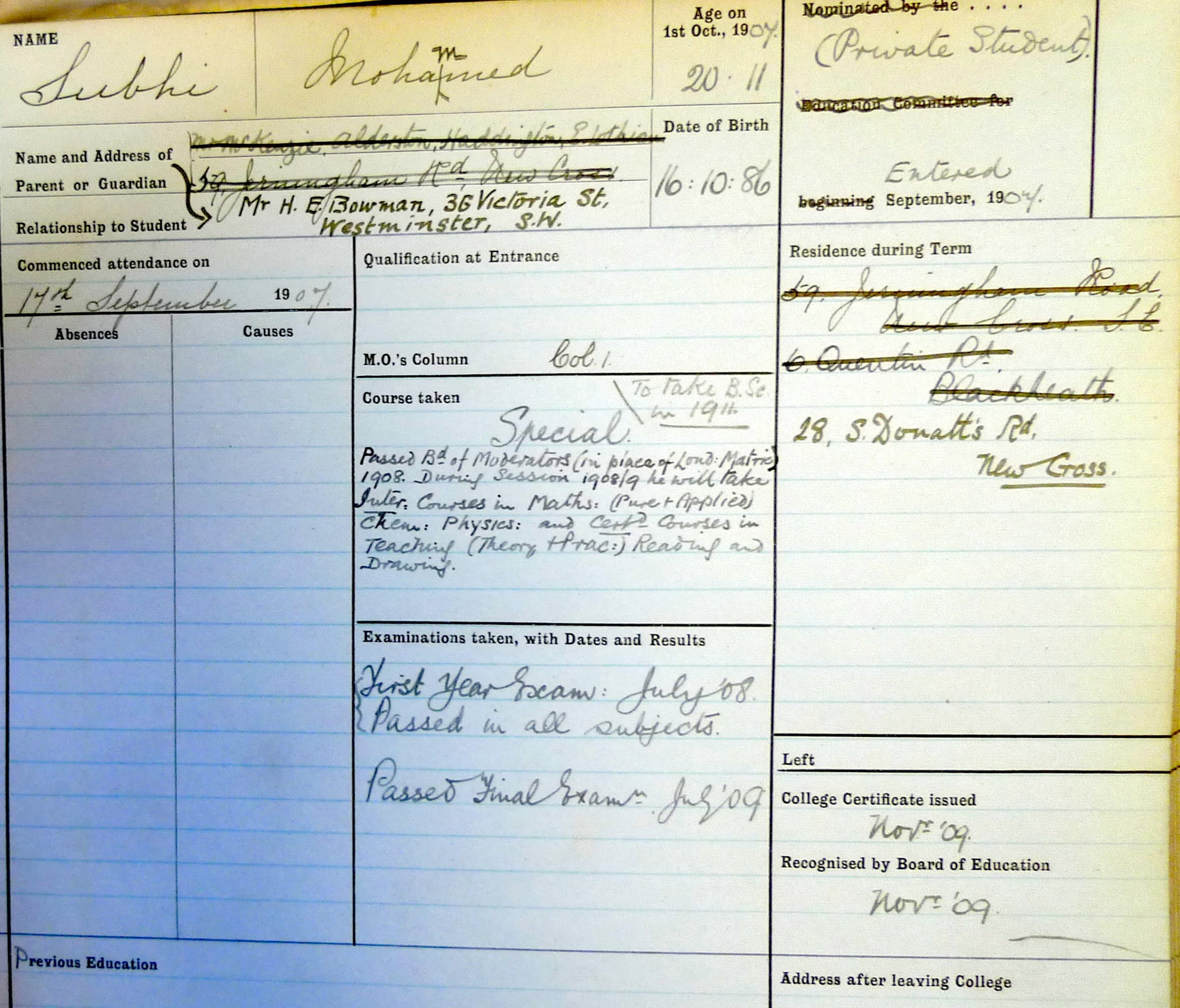
Mohammed Subhi’s student record card. Image: Goldsmiths, University of London Archive.
The College records also include a little slip of paper stating that he went on to teach at the Port Said Government School and the Khedivieh School and Engineering College.

Image: Goldsmiths, University of London Archive.
There is certainly evidence that the students and staff at Goldsmiths’ were very proud of their Egyptian students and cherished their presence.
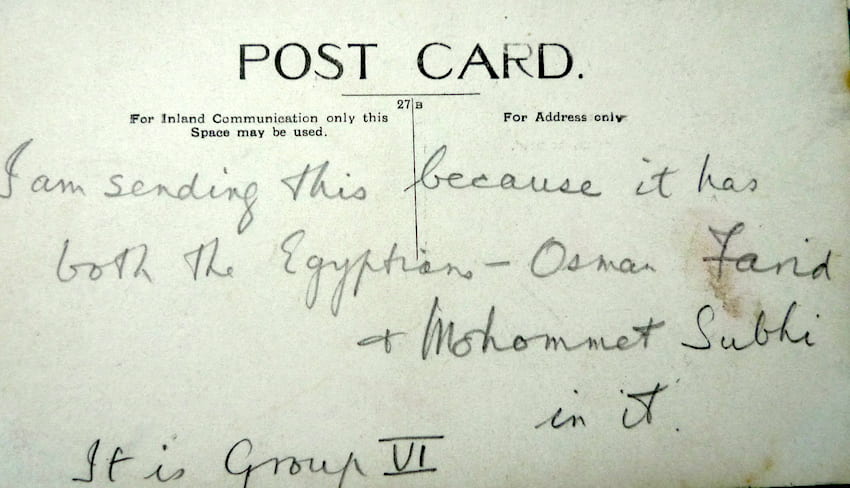
Back of a postcard sent by Meg Hinwood to her family. Image: Goldsmiths, University of London archive.
One of the women students enrolled in the same year, Meg Hinwood, enthusiastically sent a postcard of the Egyptians’ student male group (Number VI) back home to her mother and annotated with the words: ‘I am sending this because it has both the Egyptians Osman Farid + Mohommet Subhi in it. It is Group VI.’
Osman Farid seems to have been expert on horses and contributed an article to the Goldsmithian called ‘The Arab Steed.’
“In a description of the animals of Arabia, the first place is undoubtedly due to the noble steed. As a fact it is here that the animal attains its highest perfection ; not, indeed that of size ; for a true “Nejdee” of the best and purest breed seldom reaches, and never, perhaps exceeds fifteen hands in height ; but for perfection of form, symmetry of limb, cleanness of muscle, beauty of appearance- for endurance of fatigue, for docility, and for speed maintained to distances so long as to appear incredible, the “Nejdee” steed acknowledges no equal.
The animal is too well-known to require minute description. Reared under an open shed, and early habituated to the sight of men, to the sound and glitter of weapons, and to all the accessories of human life, the colt grows up free from vice or timidity and even acquires a degree of perfection in intelligence and surprises every stranger.
Colts are ridden early- too early, indeed- in their third and, even second years, and are soon broken into a steady walk, to a canter, and to the ambling pace which is a special favourite with Arab riders.
Racing, an Arab amusement from time immemorial, and the game of “jersed” : a kind of tournament of mock fight with blunt palm sticks, highly popular throughout the peninsula of Arabia, complete with training both as to wind and pace.
Of all niceties of grooming, Arabs are masters ; and their natural kindness to animals, together with the care which every reasonable man bestows on a valuable article of property, ensures to an Arab steed very good treatment at the hands of his owner. An Arab, flying for his life, has, indeed, been known to give the only morsel of dry bread about him to his steed, rather than eat it himself- an act in which self-preservation had probably as large a share as affection.”
Mr Fareed must have been getting used to Europeans changing the spelling of his forename and surname at every turn, for the Goldsmithian represented ‘Osman’ as ‘Othman.’
His article was somewhat heavily derived from the entry in the 10th and 11th editions (1902) of Encyclopedia Britannica to the point that if it had been submitted as assessment in the present age, there may have been questions about plagiarism.
The following sentence is an exact match with the Britannica entry: ‘Reared under an open shed, and early habituated to the sight of men, to the sound and glitter of weapons, and to all the accessories of human life, the colt grows up free from vice or timidity, and even acquires a degree of intelligence that surprises a stranger.’
To what extent was Mr Fareed copying this text in an ironic manoevre to give his largely European readers a mirror of what he was seeing and they expected to be reading?
It was some kind of reflection of the projected image and symbolism of how the European mentality constructed their identity of ‘The Arab Steed.’
The Egyptian students would have had to tolerate the patronising and exasperating tendency for European Orientalism of their culture.
One can imagine how many times they could been enticed into conversations about Rubáiyát of Omar Khayyám, a translation by the English poet Edward Fitzgibbon from a Persian, not Arabic, source.
Edward Said articulated in his seminal text long standing perceptions and concerns experienced by Arabs who had to negotiate the European Imperialist world.
Mr Fareed and Mr Subhi were attending Goldsmiths’ College at a time of simmering nationalist discontent in Egypt.
There had been a state of British indirect rule from 1882.
A British military force defeated the Egyptian Army at Tel el-Kebir in September and took control of the country.
Along with the French the British harvested the country’s substantial foreign currency earning asset, the Suez Canal.
Under what became known as ‘Protectorate status’, the British Empire dominated, interfered with, and manipulated Egyptian affairs until a revolution in 1952 overthrew the puppet monarchy, established a republic, and expelled all British advisors.
Their enrolment in 1907 was only a year after the Denshawai incident of 1906 where pigeon shooting by British officers, and protests by local villagers that they were killing the very birds raised by them as a source of livelihood, led to injury and death.
The excessive military and judicial crack-down, that included brutal, humiliating and public execution, added insult, injustice and outrage.
The Denshawai incident has been described by some historians as the turning point in galvanising majority Egyptian opinion against British occupation and dominance.
The loss of life was not on the scale of the Jallianwala Bagh/Amritsar massacre in British India in 1919.
But it had a similar impact and hurt on Egyptian national consciousness.
That’s So Goldsmiths– a forthcoming history of the university is being researched and written by Professor Tim Crook.